How to Grow Cucumbers for Beginners
If you are looking for tips on How to Grow Cucumbers for Beginners you are in the right place. This vegetable is perfect for any gardener and will give you a big harvest on just a few plants.
Another great veggie to add to your gardening 101 list that you can use to grow all the food you need in your backyard.
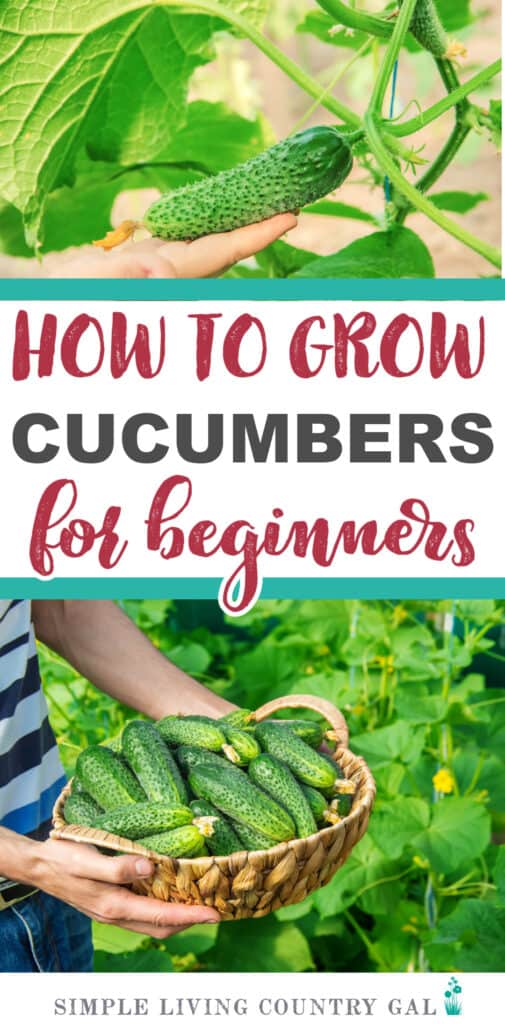
Cucumbers are one of my favorite vegetables, so you can always find a few in my kitchen. My favorite way to eat cukes, as we like to call them, is whole like you would an apple. My husband, on the other hand, prefers them as a pickle, hot and spicey.
Why are cucumbers so popular in a garden?
The biggest reason cucumbers are a popular backyard garden choice is because they are so easy to grow.
- They do well as seeds or seedlings.
- Once planted, they are low-maintenance, making them the perfect self-sufficient plant to add to your backyard garden.
- They work great as a garden filler.
- They’re ready to eat as soon as they’re picked.
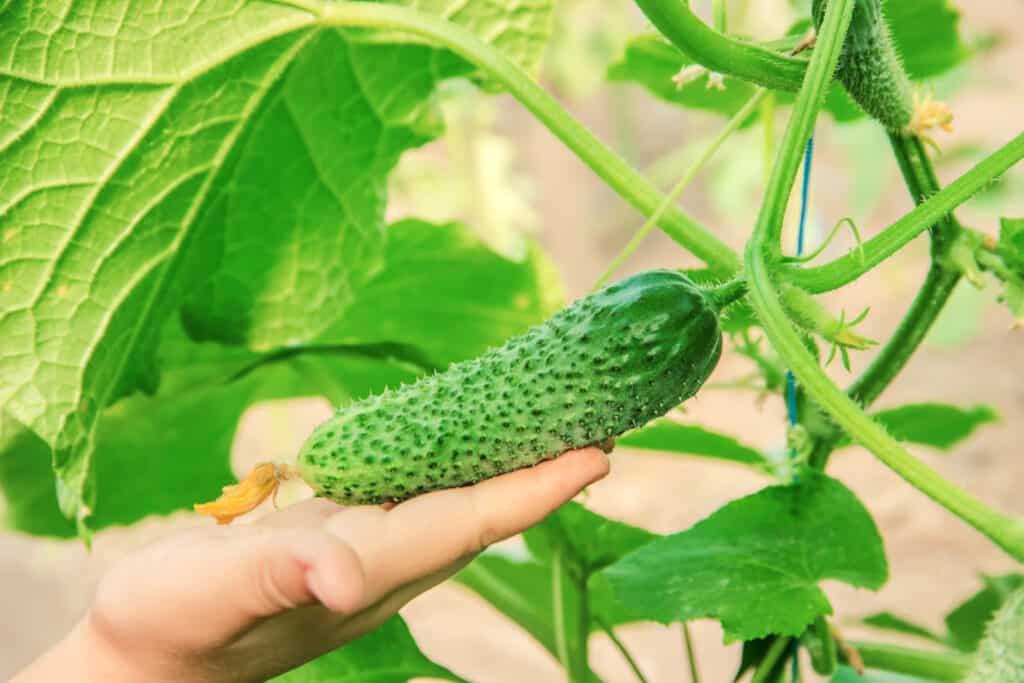
This guide to growing cucumbers is for beginners and will teach you everything you need to know to start planting and growing cucumbers in your garden.
Growing Cucumbers – What to Know
Cucumbers are a favorite addition to salads and dips, providing flavor and crunch. And while you’ll most likely find cucumbers in the vegetable area of your local grocery store, cucumbers are actually a fruit.
I was a bit surprised when I first learned this, but it makes complete sense with their sweet delicious flavor. They’re part of the Cucurbitaceae family which also includes melons and squash.
Cucumbers grow best in warm weather, making them the perfect addition to your summer garden.
The importance of flowers
When they first start to grow, you’ll notice that the plants produce flowers first. Flowers are important because if there are no flowers, there will be no cucumbers.
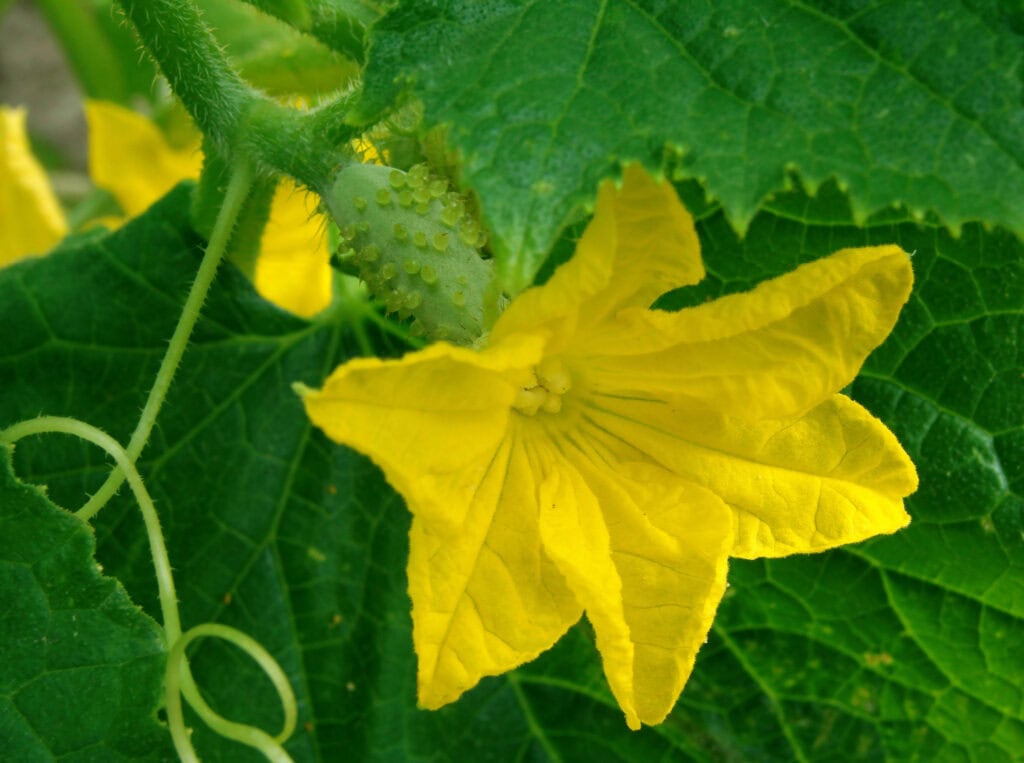
Plants will produce both male and female flowers that attract the bees needed for pollination. While it’s possible for a female flower to produce a cucumber without being pollinated, it will have far fewer seeds than your average cucumber.
Cucumber Varieties
There are several varieties of cucumbers to choose from. The two most common ones are English cucumbers, also known as hothouse cucumbers and garden cucumbers. These are the two most commonly seen in your grocery store’s produce area.
English Cucumbers
English cucumbers have a thin skin and a minimal number of seeds. They’re best enjoyed raw, sliced in a salad or on a sandwich.
Garden Cucumbers
Garden cucumbers are the most common and the ones you typically find at your local store. They have a wax coating that helps the fruit retain moisture. Garden cukes have a thicker skin that can sometimes be bitter so it’s best to peel these cucumbers before eating.
Other cucumber varieties include:
- Armenian – similar to English cucumbers.
- Gherkins – very small and best for pickling.
- Kirby – short and bumpy, best enjoyed raw but can be pickled.
- Persian – very similar to English.
- Lemon – yellow and round, the size of a fist, and looks like a lemon, great raw and pickled.
All varieties are easy to grow and are very flavorful. Some are best enjoyed raw while others are better for pickling so which variety you choose to grow depends on how you plan to enjoy them.
What You Need to Grow Cucumbers
Before you grab that shovel there are a few things to consider first. If you have plenty of space, a vining variety of cucumber will work best for you. If you are short on space, you may want to choose a bush as their vies are much shorter.
If you choose vining no matter how much space you have a trellis can be a good option. This will help to keep the vines up off the ground limiting damage to your other plants. If you choose to use a trellis such as this one though, be mindful of the placement so that you don’t block the sun from the rest of your garden.
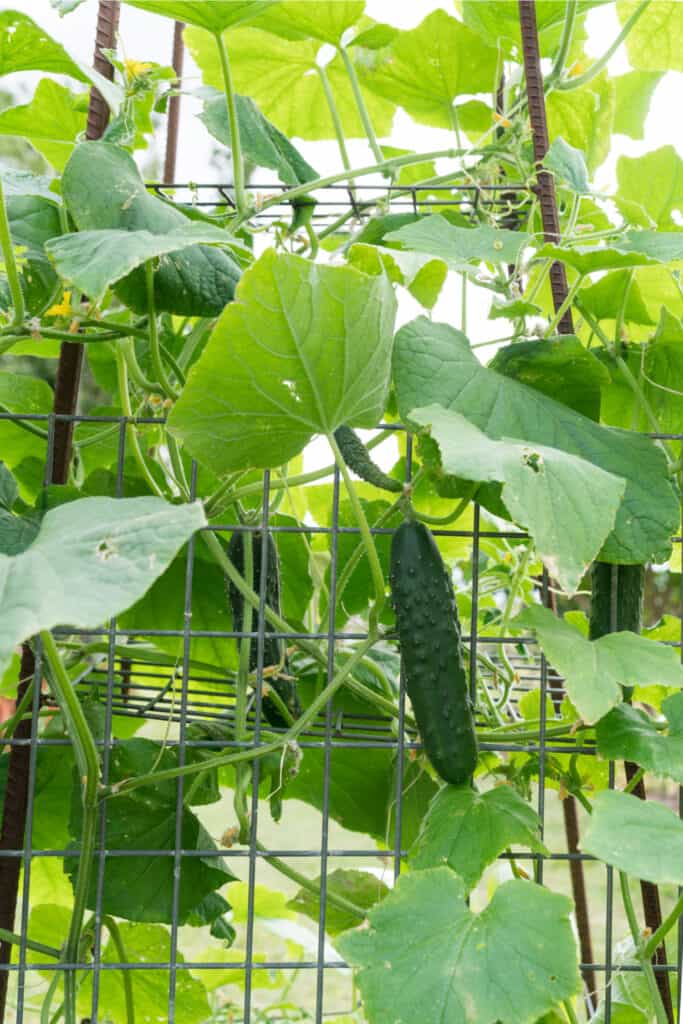
Depending on the current temperatures in your area, you may want to start your cucumber plants indoors and move them outside later once the last frost has passed. Cucumbers do not like cold weather.
For this reason, if you live in a colder area you can jump-start your growing season by starting seeds indoors and planting outside once the temperatures are consistently over 65 degrees.
Cucumber plants require full sun and regular watering to grow healthily and produce a good harvest. If you use containers or live in a wet area, it is important to know that they will also need drainage to deter root rot with your plants.
Wet Gardening Solutions:
- Square Foot Gardening for Beginners
- Container Vegetable Garden Ideas
- Easy Container Gardening for Beginners
Planting Cucumber Seedlings
If you live in a cold area, starting your plants indoors can help extend the growing season. These young plants are known as seedlings, and by germinating indoors, it allows you to control the soil temperature until you are able to transplant them into your garden.
It’s best to give your plants three to four weeks of indoor growing time before replanting them outside. Before taking them outside, double-check for the last frost.
Another bonus to using seedlings is they are less susceptible to cucumber beetles than seeds are.
Planting cucumber seeds
A common way to grow cucumbers is with seeds, and for many, this option is a good one. Just know that if you do choose to use seeds in your garden, it will take some time for those seeds to germinate. This means you will be harvesting a few weeks later with seeds, so keep that in mind.
Another thing to watch for is some seeds may also fall prey to pests during the germination process so your harvest may not be as big.
Temperature
Outdoor and soil temperatures should both be above 65 degrees before planting. Cucumbers do not like cold weather and lower temperatures can stunt the growth of your harvest and keep seeds from sprouting.
Sun
Cucumbers love early morning sun so plant them where they’ll get the best morning light. Look to plant in an area that receives at least 8 hours of sunlight per day to ensure a healthy crop.
Soil
Cucumbers need rich, fertile soil to thrive and the soil should be light and airy for good drainage. When planting be sure not to pack the soil down over the seeds. To ensure your soil is at its best you can add in about 6 to 9 cups of compost (a few shovels worth) to each planting area.
The compost will add the necessary nutrients for the cucumber plants. Another bonus is as you work the compost into the soil you will, in turn, loosen things up promoting good drainage.
The soil should have a pH of 6.8 or higher for the healthiest growth. Remember, the soil needs to be above 65 degrees. If you need to warm the soil, you can place a black plastic sheet over it. If you are not sure of your soil’s pH you can use an inexpensive pH soil test kit.
Watering
Consistent watering is key to growing a healthy harvest. Cucumber plants need at least one inch of water a week, more if the temperatures in your area are high. Use this simple test to see if your plants need more water.
Put your finger in the soil up to your first joint and test the soil for dryness. If it’s dry, water. Remember, inconsistent watering will create bitter fruit.
HIRALIY 50ft Drip Irrigation Kit Plant Watering System 8x5mm Blank Distribution Tubing DIY Automatic Irrigation Equipment Set for Garden Greenhouse Flower Bed Patio Lawn




When in doubt, remember this watering tip. The best time to water is in the morning or early afternoon. Water slowly, allowing the water to soak into the soil, and avoid the leaves. Getting the leaves wet can increase the risk of disease.
Tips on Watering Cucumbers
Use these tips to water your plants giving them the best defense against pests and soil born diseases.
#1. When watering your plants, try to avoid watering at night. This is because you do not want water to lay on the leaves overnight, as this can cause fungus.
#2. When watering during the day, the sun will help to dry the leaves out and keep them from becoming vulnerable to issues later on.
#3. Water close to the ground to prevent soil from splashing up onto the leaves.
#4. Your goal is to water the roots so keep your focus at the base of the plant and not the vines.
#5. Use mulch to help the soil absorb and retain moisture. Mulch will also help deter weeds later on giving you a healthier plant.
#6. Finally, water seedlings more frequently and increase watering to a gallon per week once the fruit starts to form.
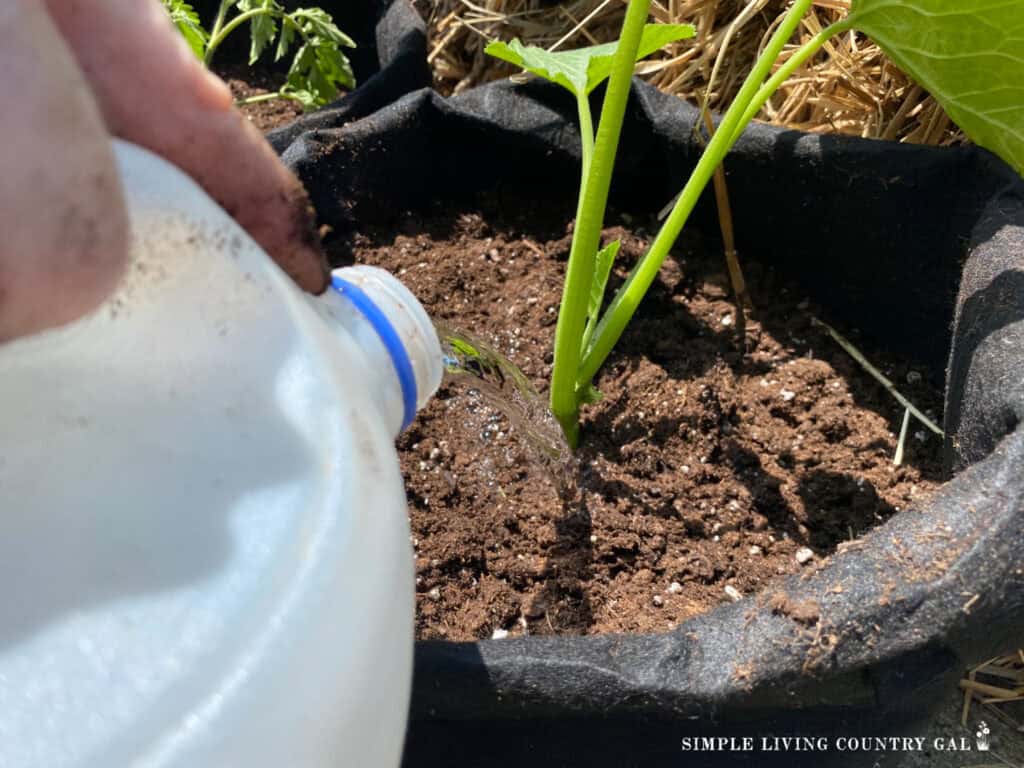
Fertilizing
Once the plants start to sprout, you may want to side-dress them with compost for more nutrients. You can also use a liquid fertilizer with low nitrogen, high potassium, and a phosphorus formula.
Apply it at planting, a week after blooming, and every three weeks after that. You can apply the fertilizer to the soil around the plants and gently work it into the ground.
Be careful not to over fertilize or the plants will become stunted.
How Many Seeds to Plant
A healthy plant can yield 20 cucumbers in a growing season. If you love cucumbers you can plant 2 plants per person giving you plenty to enjoy.
If you plan to make pickles, a good rule is to plant 2-3 plants per quart of pickles. If you have never done pickles before, Small Batch Refrigerator Dill Pickles are a great place to start.
Planting cucumbers
There are a few things to consider when planting cucumbers.
Spacing
Since cucumbers are vining plants you will need to plan to have enough spacing for those vines to grow.
In the ground, you will want to have at least 6 feet of space between each plant. If you are growing in containers, you will need support for the vines to grow vertically, or you can use hanging containers and let the vines flow downward.
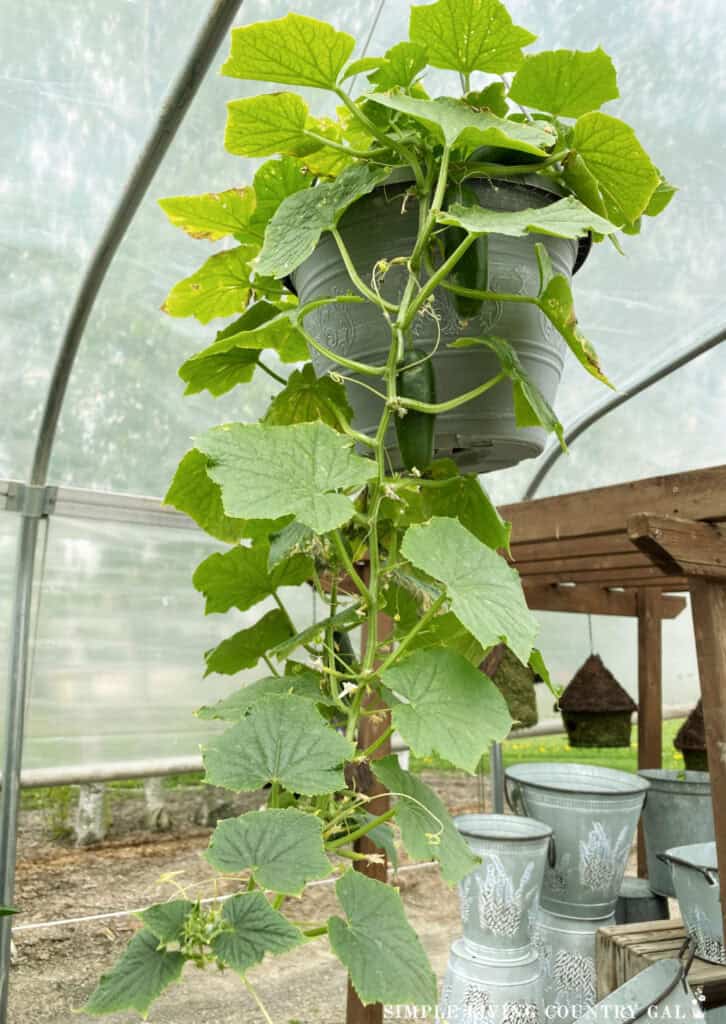
Depth
I like to plant cucumbers in raised mounds as this helps limit root rot from occurring. Root rot is when the roots sit in wet soil.
Cucumber plants are susceptible to rot so “raising” the plant a little will help to keep the stem out of sitting water in a heavy rain or watering. It’s best to plant cucumber plants in mounds or hills to protect the stems. To do this, create a tapered mound of soil in your garden for each plant that is about 18” in diameter and about 3”-4” high in the middle.
You can plant two plants per mound which will allow them to intertwine during growth and provide additional support for each other.
Be sure to mulch between mounds to keep weeds to a minimum. You can use cut grass, straw, or other healthy material.
Thinning Cucumber plants
Cucumber plants may need to be thinned out once they sprout to allow for plenty of room for growth. A good plan is to thin them to about 3-4 plants per mound (less if your mound is smaller).
Growing Time for Cucumbers
Cucumber plants take 4-10 days to germinate and 50-70 days to fully grow and be ready to harvest. Use this as your main marker for when to plant still keeping in mind the weather and temperatures where you live.
Square Foot Garden Planner+Guide

Growing Tips for Cucumbers
Even though cucumbers are relatively easy to grow, there are still a few tips to help your harvest be even more successful.
Tip #1. Be careful what you plant nearby, not all plants make good companions. A few bad neighbors for cucumbers are:
- Avoid growing potatoes as it may increase the risk of fungal disease.
- Avoid sage or basil as they can alter growth.
Tip #2. On the other side there are a few plants that will do very well growing nearby.
- Radishes are a very beneficial companion plant to cucumbers; they’ll help protect them from cucumber beetles and aphids.
- Dill attracts beneficial insects giving you healthier plants.
Tip #3. To keep the soil healthier, you will want to rotate where you grow your cucumbers yearly. This will cut down on soil-borne diseases. Another option is to plant in containers where the soil is changed year after year.
Tip #4. After planting, mulch around the area with straw, chopped leaves, or other organic mulch to help keep weeds away.
Tip #5. If planting seeds, cover the freshly planted seeds with netting to keep pests from digging up the seeds.
Tip #6. Gently spray the vines with sugar water to attract bees for pollinating.
Gardeners Basics, Cucumber Seeds for Planting Outdoors 8 Variety Pack Burpless Tendergreen, Beit Alpha, Marketmore 76, Armenian, Boston Pickling, Lemon, Spacemaster, Straight Eight Veggie Seeds

When to Harvest Cucumbers
Cucumber plants need to be harvested regularly to encourage more growth. Once they begin to grow and produce, pick your cucumbers so others will grow. If the harvest becomes overloaded, it will put its energy into making the existing fruit larger instead of growing new fruit.
Growing larger cucumbers may sound like a good idea but it’s actually not. Cucumbers left on the vine too long will become bitter and full of seeds.
Check your plants daily as cucumbers can grow from 2” to 12” in just a day or two.
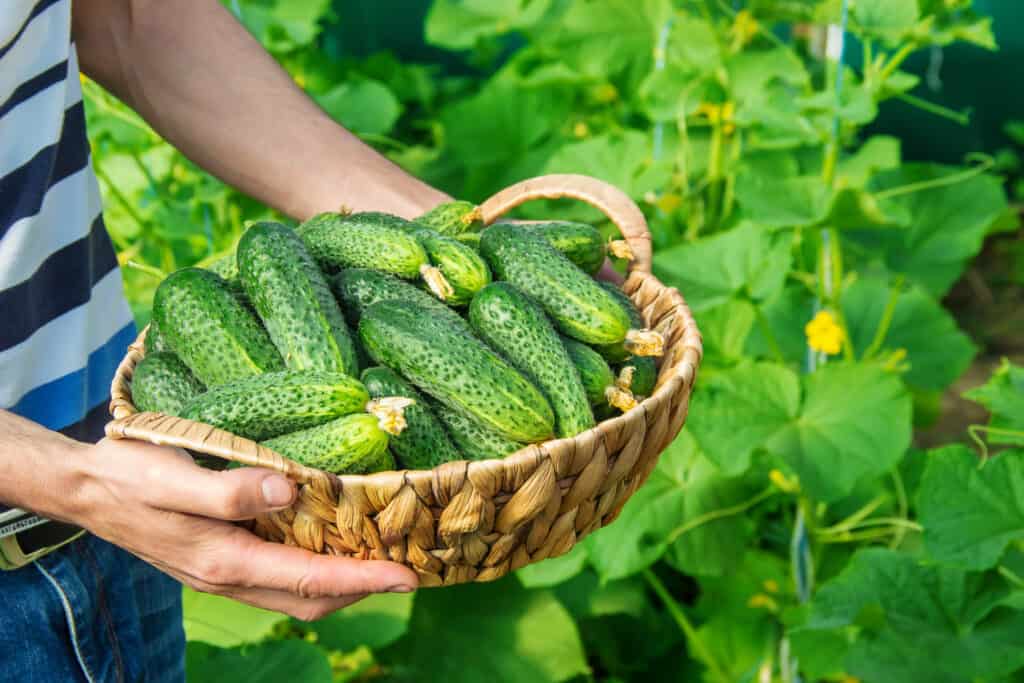
How to Store Cucumbers
Cucumbers will only keep for about 10-14 days once harvested so it is best to enjoy them sooner rather than later. For best storage, store at 45-55 degrees and in humidity of 85-95%.
Cucumbers are 90% water, wrapping them tightly in plastic wrap will help them retain moisture and preserve the taste.
Prevent Cucumber Pests
There are a few pests to watch out for when growing cucumbers. Cucumber beetles, squash bugs, and aphids love cucumber plants. These pests will attack both the seedlings and the vine, causing problems for your cucumber plants. Use these tips to prevent or fight off pests.
#1. Use Soap
You can make a homemade insecticidal soap or use neem oil to keep them from damaging your plants.
#2. Row Covers
You can also place a floating row cover over the emerging seedlings to prevent cucumber beetles from doing too much damage. This will keep pests from getting access to your plants. When using covers, be sure to remove them as the plants blossom to allow for pollination.
#3. Bugs
Welcoming ladybugs into your garden can also help to deter other pests. You can purchase them online or at a garden store. Be sure to release them in the evening out of direct sunlight in an area that’s already been watered.
Tips for cucumber diseases
Keep in mind, if you’re cucumber plants don’t grow fruit, it’s most likely not a disease but a problem with pollination. Try to attract bees to the area to resolve this issue. You can do this by planting early spring flowers near your garden.
Powdery mildew can also be a problem for cucumber plants, especially if the leaves get wet. To avoid this, water at the soil level and apply fungicides if you see any evidence of mildew.
Cucumbers are also susceptible to other vine crop diseases line bacterial wilt and anthracnose. Many hybrid plants today have a higher disease tolerance so look for a disease-resistant variety. Don’t work the garden when it’s wet as that can help spread disease.
Tips to deter animals
Some animals like deer, squirrels, and chipmunks will want to enjoy your cucumber plants. You can deter them by adding garden fencing that is either temporary or permanent. This will help to deter most critters, remember to make sure it doesn’t block the sun from your garden.
Once the blossoms start to grow into fruit, you can cover your cucumber plants with light netting to help prevent animals as well.
Remember, no matter what you use to keep your cucumber plants safe you will want to make sure the plant can still receive sunlight or cover only at night.
Now that you know how to grow cucumbers in a garden, you can soon be enjoying the tasty fruit on sandwiches and salads. You can also learn how to make homemade pickles to enjoy your harvest all year long.
Growing Cucumbers is so fun and easy. Bonus, they don’t take a lot of room and make a delicious addition to your garden. Choose your spot, start some seedlings, and get growing!












